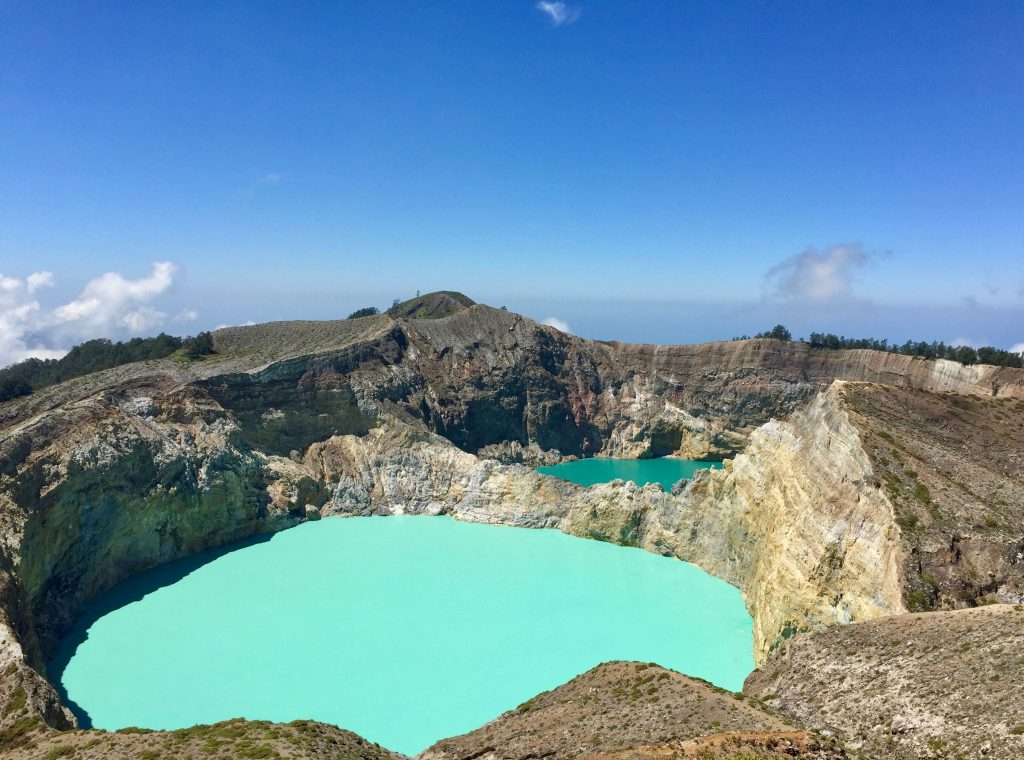After the welcoming dinner and tours of Wini, midway up the north coast of West Timor and close to the border with the Timor Leste enclave, we set sail for Alor island, 69 nm to the North. There was a good breeze at 6:30am when we set sail, but this only lasted for two hours, when the wind dropped. The spinnaker was deployed to make the most of the 6-7 knot wind, but had to be taken down after 30 minutes when the wind veered north. The Yanmar cranked to life and we motored the rest of the way, to the south of Alor and dropped our anchor in a sheltered bay after covering 44 nm.
There were three other yachts anchored there, who decided to overnight, rather than arrive at our destination at around midnight. Jon and Sue from Seattle, invited everyone around for drinks on their catamaran, Ocelot. A pleasant time was had with the yachties, before heading back to Esprit for dinner and an early night. We set off again at 6:30 am the following morning to do the last 25 nm leg, but on activating the autopilot, the GPS reported “Rudder response failure”.
We called the other yachts on VHF to let them know we were going to anchor in the next bay, to reconnect the rudder response unit arm. This requires unpacking the life raft, fenders and mooring lines in the lazarette locker, to get to the hatch, giving access to the steering quadrant. It turned out to be a good move, as we could hear the chatter on our VHF radio, reporting a strong 5 knot current slowing down the three boats already on their way up the channel between the islands of Alor and Pantar. We checked the tide tables for the channel and found that the tide would turn from low to high tide at about 10:45 am and assumed this might reverse the current.
This bay was quite a pleasant spot, so we had breakfast, fixed the RRU and Annie went snorkelling in the crystal clear water, while I settled down with a book. We set off again at 10:30 am and had a 2 knot current in our favour, going up the channel to Kalabahi town on Alor island. We anchored at 3pm. Kalabahi was a smaller and dirtier (if that’s possible) version of Kupang. The harbour was particularly trashy as it’s at the end of a fjord and doesn’t flush as well as Kupang. The locals throw everything into the water and most of the trash these days is non degradable.
Indonesia is a country consisting of 15,677 islands, including the western half of New Guinea. It has a population of over 260 million with the largest population of Muslims in the world, although it is not an Islamic state. The island archipelago stretches for over 3,200 miles from north- west to south-east, straddling the equator. Indonesia is located on the Pacific “Rim of Fire” and leads the world in many volcanic statistics. It has the largest number of historically active volcanoes (76), and has a total of 1,171 dated eruptions since European arrival.
Two of the most devastating volcanic eruptions during historical times, took place in Indonesia: the enormous eruption of Tambora in 1815 – the largest known eruption in the world, had such far-reaching effects on the climate, that for instance Europe was to experience 1816 as the year without summer. In 1883, the disastrous eruption of Krakatau was followed by severe tsunamis that killed about 30-40,000 people. The first volcano we sailed past after leaving Alor island, was Lewotolo on the island of Kawula, where we anchored overnight at the town of Balurin.
Lewotolo volcano on Kawula island.
When we reached Wodong on the island of Flores, we were able to travel overland to see the Kelimutu volcano, now dormant. It has a caldera of three lakes with different colours due to minerals such as copper and tin. Flores island stretches more than 300 nm from east to west, so we day hopped from Wodong to the west coast over four days in the company of 4 to 7 other yachts. There wasn’t much wind, so we had to motor quite a lot. Another reason for only travelling during the day, are the great number of floating fishing platforms off the coast, which are unlit during the night.
Our next stop will be the Komodo island National Park where the famous Komodo dragons and two other species of giant lizards live. We will report more in our next post.












